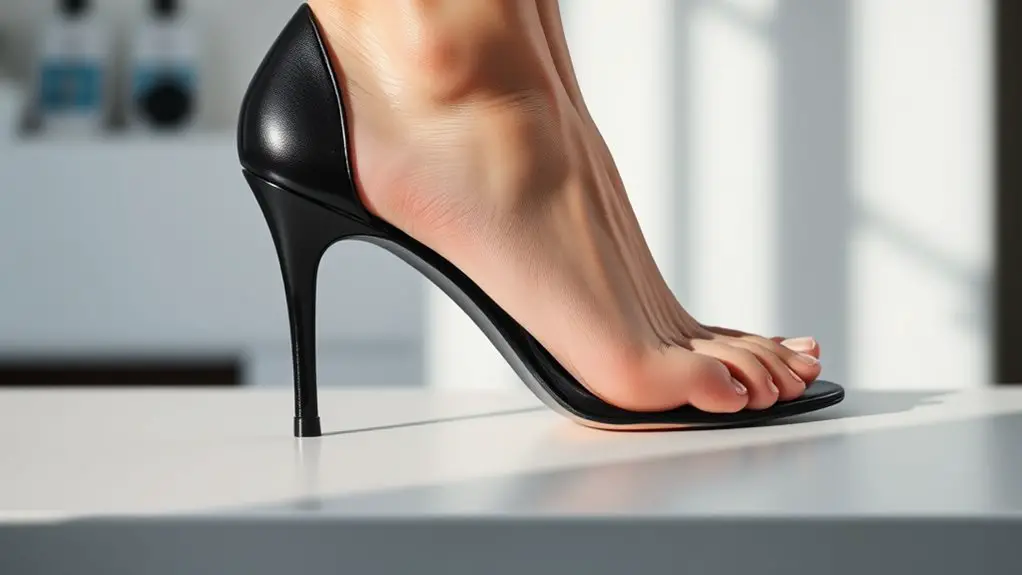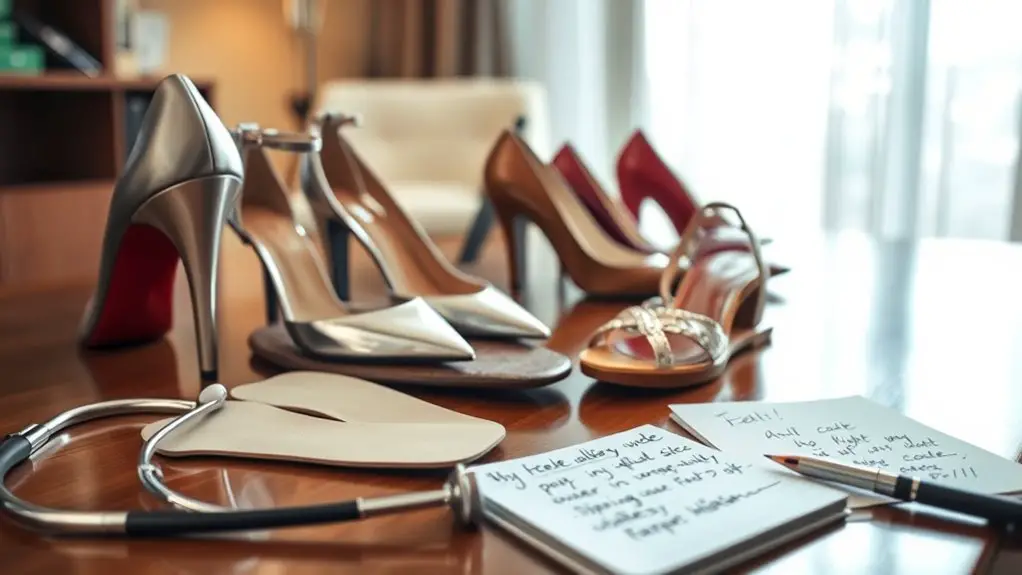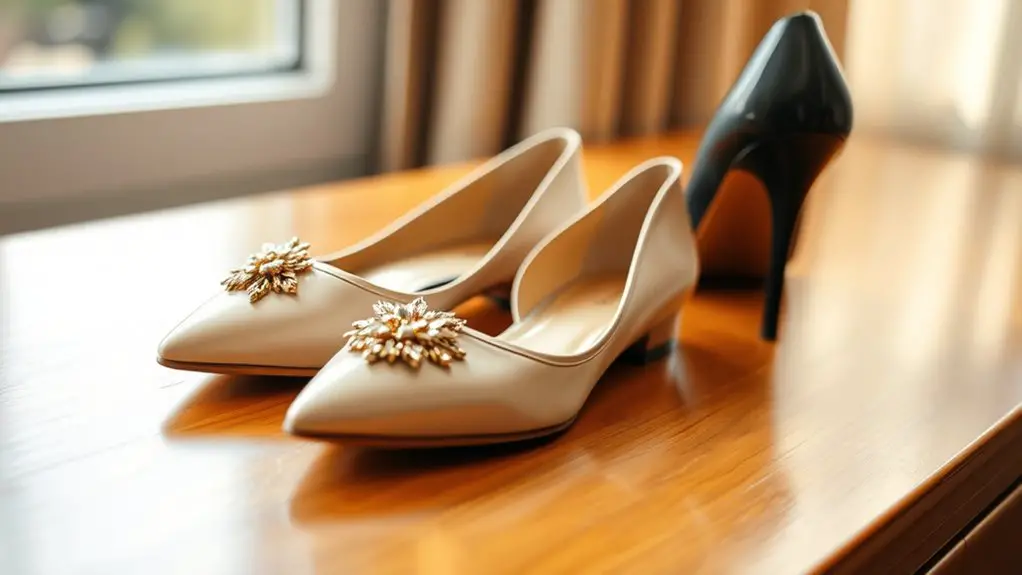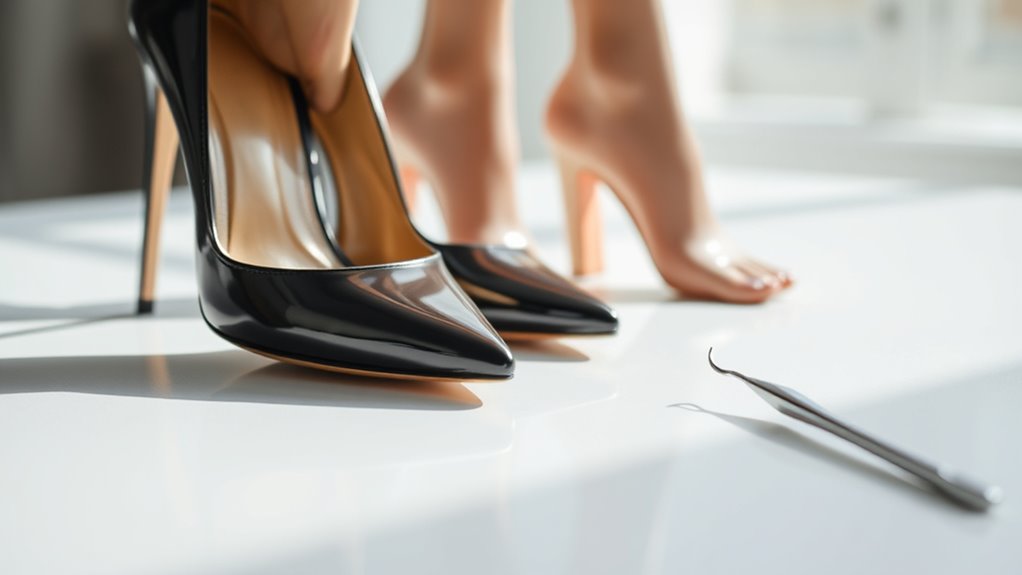High heels can be bad for your feet. Their design shifts weight forward, increasing pressure on the forefoot and leading to various issues like bunions, hammertoes, and tendonitis. Podiatrists recommend choosing lower heels with arch support, and limiting wear time. A proper fit is essential to avoid exacerbating problems. While stylish options exist, it’s important to take into account foot health for long-term well-being. There’s more to discover about balancing style and comfort.
The Anatomy of High Heels and Their Impact on Feet

When you slip on a pair of high heels, it’s essential to understand how their design affects your feet. The heel structure of high heels elevates the foot, shifting your weight forward and altering your foot biomechanics. This elevation can lead to increased pressure on the forefoot, which affects how your foot interacts with the ground.
The angle created by high heels forces the foot into an unnatural position, impacting the alignment of the ankle, knee, and hip joints. The narrow toe box can compress the toes, leading to discomfort and potentially altering your gait. Additionally, the materials used in the construction of high heels may not provide adequate arch support, further complicating foot biomechanics. Hence, it’s vital to take into account these factors when choosing high heels, as they can greatly influence your overall foot health and comfort in the long run.
Common Foot Problems Associated With High Heels
The structural design of high heels contributes to a range of common foot problems. The elevated heel height shifts your body weight forward, leading to increased pressure on the forefoot. This can result in foot pain, particularly in the metatarsal region, where discomfort and inflammation often occur. Additionally, prolonged use of high heels can lead to conditions such as bunions and hammertoes, as the unnatural position of your toes can cause misalignment.
The restricted toe box in many high-heeled shoes exacerbates these issues, causing pinching and neuromas, which are painful growths on the nerves between your toes. Moreover, high heels can strain the Achilles tendon, potentially leading to tendonitis. To conclude, while high heels can enhance your appearance, they pose significant risks to your foot health that you should be aware of.
Podiatrists’ Recommendations for Safer Heel Wear

Although high heels can be stylish, podiatrists recommend several strategies to minimize the associated risks to your foot health. First, consider the heel height; opting for lower heels can greatly reduce pressure on your feet and decrease the risk of injury. A heel height of two inches or less is often advised for more comfortable wear.
Additionally, look into cushioning options. Shoes with built-in arch support and padded insoles can help absorb shock and alleviate discomfort. If the heels you choose lack adequate cushioning, consider using gel inserts or orthotics for added support.
Moreover, limit the duration of wear. Taking breaks to rest your feet can help prevent fatigue and strain. Finally, it’s crucial to verify your shoes fit properly—tight or loose shoes can exacerbate foot problems. By following these recommendations, you can enjoy your heels while safeguarding your foot health.
Finding a Balance Between Fashion and Foot Health
While many people prioritize aesthetics in their footwear choices, it’s essential to find a balance between fashion and foot health. High heels may align with current fashion trends, but they can compromise foot support and lead to long-term issues. Here are some key considerations:
| Aspect | Fashion Trends | Foot Support |
|---|---|---|
| Heel Height | Stilettos | Low or block heels |
| Toe Box Shape | Pointed | Rounded or square |
| Materials | Synthetic | Leather or breathable |
Selecting shoes that incorporate a blend of style and comfort is vital. Look for designs that offer adequate arch support and cushioning while still reflecting your fashion preferences. Remember, your feet bear the weight of your daily activities, so investing in supportive footwear is a worthwhile endeavor for both your style and long-term health.
Alternatives to High Heels for Style and Comfort

When seeking stylish footwear that prioritizes comfort, you don’t have to sacrifice aesthetics for foot health. Comfortable flats are a versatile option, offering a range of designs that can complement both casual and formal attire. Look for styles with cushioned insoles and supportive arches to enhance comfort throughout the day.
Stylish sneakers have also gained popularity as a fashionable alternative. Many brands now offer sleek designs that maintain a modern look while providing ample support and shock absorption. You can easily pair these with various outfits, from dresses to tailored pants, without compromising on style.
Additionally, consider loafers or ankle boots with a low heel, which can provide a sophisticated appearance without the discomfort associated with high heels. By choosing these alternatives, you can maintain your personal style while prioritizing your foot health and overall comfort.
Frequently Asked Questions
Can High Heels Cause Long-Term Damage to Foot Structure?
Wearing high heels regularly can alter your foot structure, potentially leading to long-term effects like misalignment, pain, and increased risk of conditions such as plantar fasciitis. It’s important to take these risks into account when choosing footwear.
Are There Specific Exercises to Counteract High Heel Effects?
To counteract high heel effects, you can engage in foot strengthening and flexibility exercises. These activities help improve muscle balance, enhance flexibility, and reduce discomfort, promoting healthier foot mechanics and overall well-being.
Do High Heels Worsen Existing Foot Conditions?
If you’re already dealing with foot pain or joint issues, high heels can definitely exacerbate those conditions. The unnatural positioning forces your feet into compromised postures, increasing strain and potentially worsening your existing problems.
How Often Should I Take Breaks From Wearing High Heels?
To maintain foot health, you should take breaks from high heels every couple of hours. Consider heel alternatives, like supportive flats, during these breaks to alleviate pressure and reduce the risk of discomfort or injury.
Are There Any Age Restrictions for Wearing High Heels Safely?
There aren’t strict age restrictions for wearing high heels, but youth guidelines suggest caution for younger individuals. Age recommendations vary, emphasizing moderation and proper fit to avoid potential foot issues throughout different life stages.



